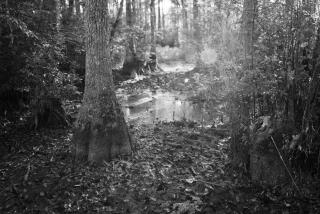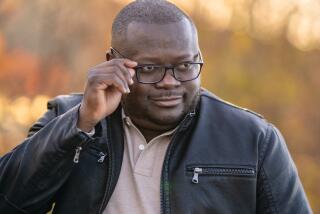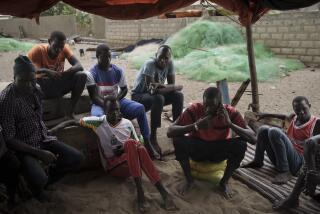Searching for Africa’s Lost City : THE UNVEILING OF TIMBUCTOO; The Astounding Adventures of Caillie, <i> By Galbraith Welch (Carroll & Graf: $11.95, paper; 368 pp.). </i>
- Share via
In 1828, an unschooled shoemaker’s apprentice from a small French village disguised himself as a Muslim pilgrim and walked “with a pint of beads and a yard of trade cloth” from the Guinea coast of Africa to Timbuctoo, the ancient trading and cultural center, university town, and exotic lost city on the edge of the Sahara. Lost, that is, to Europeans. Africans knew where it was. Rene Caillie then rode on a camel north across the desert to Tangier, completing a journey of more than 3,000 miles through territory filled with people so hostile to European Christians that some Europeans thought he made the whole thing up. Apparently, he didn’t. After examining him thoroughly, the Geographical Society of Paris awarded him the 10,000-franc prize it had offered to the first European who would go to Timbuctoo and return to tell about it. (An Englishman, Maj. Alexander Laing, had in fact reached the city in 1826, stood around in his army uniform taking notes and making sketches, then was murdered by Tuareg tribesmen when he left.)
According to Galbraith Welch, whose 1939 account of the adventure has been reissued by Carrol & Graf, Caillie was the first European to have accomplished the trip and return. It should be pointed out that this claim is mistaken. A Florentine merchant named Benedetto Dei went there in 1470 and came back with an account; and in the 16th Century, the Spanish Muslim Leo Africanus also visited Timbuctoo and returned to write the description of the city upon which most of its legendary splendor was based.
Still, Caillie’s accomplishment was quite extraordinary, even if Timbuctoo was in decline by the time he got there. For one thing, Africans (especially Muslims) were far more suspicious of Europeans in the 19th Century than in the 15th or 16th, and with good cause. The slave trade had ravaged western Africa; French and English towns had been established on the coast, and Mungo Park, with a small army of volunteers, had traveled to the Niger River in 1805, killing natives indiscriminately until he himself was killed. In other words, colonialism had begun, and Africans knew it. Sixty years later, Timbuctoo was part of French West Africa, and by the first decade of the 20th Century, nearly all of the continent had been carved up by Europe. The Paris Geographical Society knew what it was doing when it offered that prize. According to Welch, the French “believed Timbuctoo was the key to a great market from which they were being excluded by native pride and secretiveness.” Its discovery, they thought, “would make everybody’s fortunes.”
Yet, the French snubbed Caillie when he asked for their help. They thought his scheme harebrained: to learn the Arabic patois spoken by nomadic desert tribes, to master the various native languages, study the Koran and dress as a Muslim. It helps to know that Caillie was puny not just in physique but social consequence. He wasn’t in the military; he was working class; his alcoholic father had died in jail. In other words, he hardly presented the image of the Great White Explorer, and this in fact is his story’s appeal. He had no financial backing, and doesn’t seem to have been bent so much on conquest and fortune as on fulfilling a dream first conceived when as a child he read a French translation of “Robinson Crusoe.” Where Stanley took six tons of supplies with him on his search for Livingstone, Caillie had a pack weighing less than 100 pounds. Where Park murdered natives left and right, Caillie never records during all his travels “having struck a blow.” He was, in sum, a small, stubborn, shrewd white trickster who succeeded by his wiles and quick wit--a fly in the giant’s ear. He concocted a preposterous story: He was an Egyptian Muslim kidnaped by the French and forced to adopt Christian ways, but had escaped and was now trekking to Mecca. Whether anyone believed it is perhaps irrelevant. It entertained those he met; it worked. In Timbuctoo, this fabricated story was written down by his Muslim protectors and placed in the city’s archives.
He endured terrible thirst, hunger, scurvy, fever, killer bees, and a hot desert wind that could explode glasses in men’s hands. When he finally arrived in Morocco reduced to utter poverty, he was attacked by a pack of wild dogs. Yet, he was happy! He reminds us of the protagonist in Conrad’s “Youth,” oblivious to the misery around him, including his own.
Welch’s description of his story holds up after 50 years--but with important caveats. She can evoke Africa with a lyrical gusto; the streets of a desert town, she says, are so “narrow and devious” that one suspects their builders “hoped that the Saharan sun would lose itself in the maze.” Snakes, jewel-like flowers, gigantic pits dug by the feet of elephants in the banks of the Niger, “lean angry camels”--all these are here in profusion. But so is the embroidery of pulp fiction. To dramatize the dangers that Caillie encountered, she makes Africa a dark continent known to Europeans only through the “gossip of black traders, told in shuddering whispers.” We get “men stranger than wild beasts,” whispered rumors of delicious and horrible cruelties, and “tales of women possessed of charms such as the white world never knew.” At its worst, this is merely one more story of the white traveler “penetrating” the shop-worn heart of darkness. Its incipient racism becomes quite explicit in rapturous passages in which the author can’t help but “almost regret the old slave days.”
Perhaps it’s unfair to criticize anyone for failing to think beyond the terms of her culture, but we remind ourselves that this is 1939. The sad truth is that up to 1939 and beyond, the construction of racial attitudes was regressive, not progressive. The Portuguese Jesuits in 16th-Century Ethiopia, for example, display none of Welch’s romantic racism. Racial stereotypes weren’t so much the cause of four centuries of slavery--culminating in colonial partition--as their result and belated justification.
For these reasons I would have preferred a new book on Caillie instead of this one--or even a reissue of his own account, which was translated into English in 1830. Welch pumps up her little hero too much, and makes the dangers he passed through a vivid but two-dimensional cartoon. Caillie’s brave, foolish, and shrewd game needs a drier imagination to evoke it. We need to see its wit, but also its psychological implications: 17 months disguised as the Other makes for inner changes that Welch never contemplates. Caillie was grilled by skeptical geographers in France and grilled on his trip at every stop by villagers and tribesman suspicious of this Christian disguised as a Muslim who said he’d been forced to disguise himself as a Christian. I like to think that he fabricated the whole thing; that he got only so far and based the rest on native accounts; that his story was as much of a fiction as his disguise; that Rene Caillie was the ultimate trickster; that he wrote in a grass hut far from Timbuctoo for armchair travelers who will also never get there.
More to Read
Sign up for The Wild
We’ll help you find the best places to hike, bike and run, as well as the perfect silent spots for meditation and yoga.
You may occasionally receive promotional content from the Los Angeles Times.






